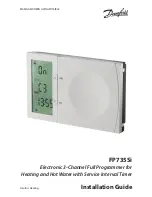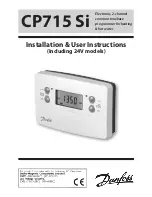
- 11 -
• A
u
--
Absorption
voltage adjustment. Controls the
length
of allowable bulk voltage. Starts at value set by battery
program currently in use. Adjustment spans from 13.5 to 14.8 volts. To reverse direction of scroll, release magnet
and wait for LED to display
a
u
code. Re-activate switch with magnet and release when desired value is indicated.
• A1
c
--
Absorption
time adjust
ment
. Controls the minimum
length of
non-calculated absorption charging. Standard
value set by battery program selected. Adjustment spans in tenths of hours from 12 minutes to six hours. To reverse
direction of scroll, release magnet and wait for LED to display
a1
c
code. Re-activate switch with magnet and release
when desired value is indicated.
• F
u
--
Float
voltage adjustment. Controls the maximum limit of allowable float voltage. Starts at value set by battery
program currently in use. Adjustment spans from 13.0 to 13.8 volts. To reverse direction of scroll, release magnet
and wait for LED to display
a
u
code. Re-activate switch with magnet and release when desired value is indicated.
• F1
c
--
Float
time adjustment. Controls the minimum time period for non-calculated float charging. Standard value
set by battery program selected. Adjustment spans in tenths of hours from 12 minutes to six hours. To reverse direc-
tion of scroll, release magnet and wait for LED to display
a1
c
code. Re-activate switch with magnet and release when
desired value is indicated.
• ap
-- Amp Manager. Governs the maximum field potential percentage
allowed. Can be used to de-tune alternator output. When “AP” is displayed
on the LED, activate switch. “OFF” code will be displayed. Release switch.
When “AP” is indicated, re-activate and hold switch with magnetic tool.
Display will decrement through percentage values (
98, 96, 94,
and so on).
Release when the desired percentage is indicated.
• e
u
-- Equalization voltage adjustment. Governs equalization/conditioning
voltage. Starts at value set by battery program currently in use. Adjustment
spans from 14.8 to 16.5 volts. To reverse direction of scroll, release magnet
and wait for LED to display
e
u
code. Re-activate switch with magnet and
release when desired value is indicated.
• e1
c
-- Equalization time adjustment. Controls the time period for equaliza-
tion/conditioning charging. Adjustment spans in tenths of hours from 30
minutes to three hours. To reverse direction of scroll, release magnet and
wait for LED to display
e1
c
code. Re-activate switch with magnet and release
when desired value is indicated.
• fba
-- Controls the criteria the regulator uses to
determine how hard the alternator has to be work-
ing to stay in calculated bulk charging mode.
Factory set at 75% field output. Raising
“fba”
short-
ens calculated bulk charge time. Lower ing
“fba”
increases calculated bulk charge time. Adjusted in
2% increments. Span of adjustment is 16% to 96%.
To reverse direction of scroll, release magnet and
wait for LED to display
“fba”
code. Re-activate
switch with magnet and release when desired value
is indicated.
• ffl
-- Controls the criteria the regulator uses to
determine how hard the alternator has to be work-
ing to stay in calculated absorption charging mode.
Factory set at 75% field output. Raising
“ffl”
short-
ens calculated absorption charge time. Lower ing
“ffl”
increases calculated absorption charge time.
Adjusted in 2% increments. Span of adjustment is
16% to 96%. To reverse direction of scroll, release
magnet and wait for LED to display
“ffl”
code. Re-
activate switch with magnet and release when
desired value is indicated.
• al1
-- Controls the setpoint at which point field
current is reduced when the the alternator temper-
ature sensor indicates an over-temp condition at the
alternator. Requires temperature sensor installa-
tion. Adjustable from 30°C to 125°C.
Using the Amp Manager
The Max Charge’s Amp Manager feature
is a unique and powerful tool that’s
capable of addressing and solving a
range of potential issues. By using the
Amp Manager to limit alternator horse-
power load, you can minimize belt dust-
ing and slippage caused by a too-small
belt. Inversely, if your alternator is under-
sized to support a large battery bank, the
Amp Manager function can be used to
reduce demand on the alternator and
minimize the possibility of alternator
overheating.
Notes On Battery Equalization
While the Max Charge regulator is capable of completing an equal-
ization exercise, keep in mind that it may be preferable to conduct
an equalization by using a shorepower charger.
Typically, an equalization may require that the batteries be kept at
a heightened voltage level for several hours at a time. As a result, it
may be inconvenient to be able to run your engine for the required
time period. In addition, most battery manufacturers recommend
that the batteries be closely monitored (most flooded batteries
should be inspected for specific gravity readings periodically, and
boiled electrolyte be replaced during the equalization cycle). This
may be difficult or impossible if attempting to equalize while under-
way.
When considering an equalization cycle for your batteries, it is
essential to determine the time and voltage requirements of your
batteries, prior to initiating the cycle. Your battery manufacturer
should be contacted directly for recommendations. Some manu-
facturers may recommend against equalizations, which may void
warranties if attempted against recommendations.
Use added care when equalizing batteries. Intentional overcharging
of batteries can result in overheating and release of corrosive gases.
Always provide ample ventilation for batteries while equalizing.
Summary of Contents for Max Charge MC-612
Page 15: ...15...



































